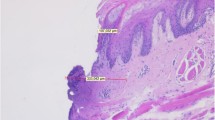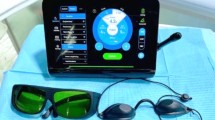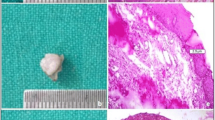Abstract
The diode laser is today widely used in oral pathology to excise lesions; however, some controversy surrounds laser surgery, specifically the accuracy of pathological diagnosis and the control over thermal tissue damage. This study aimed to establish if physical damage induced by the diode laser could affect the histopathological diagnosis and to evaluate the damage caused to the resection margins. Between 2005 and 2010, at S. Gerardo Hospital, Milan, 608 cases of soft tissue lesions localized in the oral cavity (cheek, gingiva, buccal mucosa, tongue, and lips) were examined. Specimens were excised with an 808-nm diode laser, output 1.6–2.7 W, in continuous-wave mode with fibers of 320 μm. Specimens were fixed in 10% buffered formalin solution and examined separately under an optical microscope by two pathologists. In all of the specimens, changes to the epithelium, connective tissue and blood vessels, shape of incision damage, and overall width of modified tissues were evaluated. The data for specimens larger than 3 mm excised with the diode laser were not significant in terms of stromal changes or vascular stasis, while epithelial and stromal changes were significantly more frequent in specimens with a mean size below 3 mm; the diagnosis was not achievable in 46.15%. Our data show that the diode laser is a valid therapeutic instrument for excising oral lesions larger than 3 mm in diameter, but induces serious thermal effects in small lesions (mean size below 3 mm). However, from a clinical standpoint, it is suggested necessary that the specimens taken have in vivo a diameter of at least 5 mm in order to have a reliable reading of the histological sample.




Similar content being viewed by others
References
Romanos G, Nentwig GH (1999) Diode laser (980 nm) in oral and maxillofacial surgical procedures: clinical observations based on clinical applications. J Clin Laser Med Surg 17:193–197
Angiero F, Benedicenti S, Arcieri K, Bernè E (2009) Head and neck hemangiomas in pediatric patients treated with endolesional 980-nm diode laser. Photomed Laser Surg 27:553–559
Angiero F, Benedicenti S, Romanos GE, Crippa R (2008) Sialolithiasis of the submandibular salivary gland treated with the 819 to 830 nm diode laser. Photomed Laser Surg 26:517–521
Angiero F, Benedicenti S, Romanos GE, Crippa R (2008) Treatment of hemangioma of the head and neck with diode laser and forced dehydration with induced photocoagulation. Photomed Laser Surg 26:113–118
Eversole LR (1997) Laser artifacts and diagnostic biopsy. Oral Surg Oral Med Oral Path Oral Radiol Endod 83:639–640
Vescovi P, Corcione L, Meleti M et al (2010) Nd:YAG laser versus traditional scalpel. A preliminary histological analysis of specimens from the human oral mucosa. Lasers Med Sci 25:685–691
Romeo U, Palaia G, Del Vecchio A et al (2010) Effects of KTP laser on oral soft tissues. An in vitro study. Lasers Med Sci 25:539–543
Bornstein MM, Winzap-Kälin C, Cochran DL, Buser D (2005) The CO2 laser for excisional biopsies of oral lesions: a case series study. Int J Periodontics Restor Dent 25:221–229
Capodiferro S, Loiudice AM, Pilolli G et al (2009) Diode laser excision of chondroid lipoma of the tongue with microscopic (conventional and confocal) analysis. Photomed Laser Surg 27:683–867
Tuncer I, Őzçakir-Tomruk C, Şencift K, Çöloğlu S (2010) Comparison of conventional surgery and CO2 laser on intraoral soft tissue pathologies and evaluation of the collateral thermal damage. Photomed Laser Surg 28:75–79
Zaffe D, Vitale MC, Martignone A, Scarpelli F, Botticelli AR (2004) Morphological, histochemical and immunocytochemical study of CO2 and Er:YAG laser effect on oral soft tissues. Photomed Laser Surg 22:185–189
Matsumoto K, Suzuki H, Usami Y, Hattori M, Komori T (2008) Histological evaluation of artifacts in tongue tissue produced by the CO2 laser and the electrotome. Photomed Laser Surg 26:573–577
Gandolfo S, Carbone M, Carrozzo M, Scamuzzi S (1993) Biopsy technics in oral oncology: excisional or incisional biopsy? A critical review of the literature and the authors’ personal contribution. Minerva Stomatol 42:69–75
Capodiferro S, Maiorano E, Loiudice AM, Scarpelli F, Favia G (2008) Oral laser surgical pathology: a preliminary study on the clinical advantages of diode laser and on the histopathological features of specimens evaluated by conventional and confocal laser scanning microscopy. Minerva Stomatol 57:1–7
Goharkhay K, Moritz A, Wilder-Smith P et al (1999) Effects on oral soft tissue produced by a diode laser in vitro. Lasers Surg Med 25:402–406
White JM, Chaudhry SI, Kudler JJ, Sekandari N, Schoelch ML, Silverman S (1998) Nd:YAG and CO2 laser therapy of oral mucosal lesions. J Clin Laser Med Surg 16:299–304
Rizoiu IM, Eversole LR, Kimmel AI (1996) Effects of an erbium, chromium: yttrium, scandium, gallium, garnet laser on mucocutaneous soft tissues. Oral Surg Oral Med Oral Path Oral Radiol Endod 82:386–395
Jin JY, Lee SH, Yoon HJ (2010) A comparative study of wound healing following incision with a scalpel, diode laser or Er,Cr:YSGG laser in guinea pig oral mucosa: a histological and immunohistochemical analysis. Acta Odontol Scand 68:232–238
Parker S (2007) Lasers and soft tissue: "loose" soft tissue surgery. Br Dent J 202:185–191
Fox CH, Johnson FB, Whiting J, Roller PP (1985) Formaldehyde fixation. J Histochem Cytochem 33:845–853
Johnson RE, Sigman JD, Funk GF, Robinson RA, Hoffman HT (1997) Quantification of surgical margin shrinkage in the oral cavity. Head Neck 19:281–286
Alonso FC, Jornet PL, Torres MJJ, Domingo AO (2008) Analysis of the histopathological artifacts in punch biopsies of the normaloral mucosa. Med Oral Patol Oral Cir Bucal 13:636–639
Author disclosure statement
No competing financial interests exist.
Author information
Authors and Affiliations
Corresponding author
Rights and permissions
About this article
Cite this article
Angiero, F., Parma, L., Crippa, R. et al. Diode laser (808 nm) applied to oral soft tissue lesions: a retrospective study to assess histopathological diagnosis and evaluate physical damage. Lasers Med Sci 27, 383–388 (2012). https://doi.org/10.1007/s10103-011-0900-7
Received:
Accepted:
Published:
Issue Date:
DOI: https://doi.org/10.1007/s10103-011-0900-7




